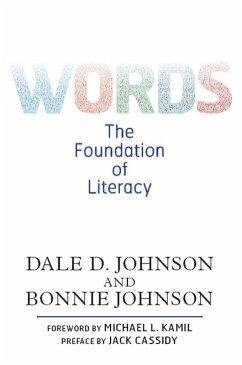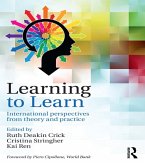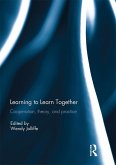39,95 €
39,95 €
inkl. MwSt.
Sofort per Download lieferbar

20 °P sammeln
39,95 €
Als Download kaufen

39,95 €
inkl. MwSt.
Sofort per Download lieferbar

20 °P sammeln
Jetzt verschenken
Alle Infos zum eBook verschenken
39,95 €
inkl. MwSt.
Sofort per Download lieferbar
Alle Infos zum eBook verschenken

20 °P sammeln
- Format: ePub
- Merkliste
- Auf die Merkliste
- Bewerten Bewerten
- Teilen
- Produkt teilen
- Produkterinnerung
- Produkterinnerung

Bitte loggen Sie sich zunächst in Ihr Kundenkonto ein oder registrieren Sie sich bei
bücher.de, um das eBook-Abo tolino select nutzen zu können.
Hier können Sie sich einloggen
Hier können Sie sich einloggen
Sie sind bereits eingeloggt. Klicken Sie auf 2. tolino select Abo, um fortzufahren.

Bitte loggen Sie sich zunächst in Ihr Kundenkonto ein oder registrieren Sie sich bei bücher.de, um das eBook-Abo tolino select nutzen zu können.
This is a groundbreaking book for teachers, administrators, and education students. Dale and Bonnie Johnson present a fresh, inspiring reminder of why studying language (from word origins to word structure) is such a vital first step in the development of students' vocabulary, literacy, writing skills, and overall ability to learn.
- Geräte: eReader
- mit Kopierschutz
- eBook Hilfe
- Größe: 2.74MB
Andere Kunden interessierten sich auch für
![Learning to Learn (eBook, ePUB) Learning to Learn (eBook, ePUB)]() Learning to Learn (eBook, ePUB)46,95 €
Learning to Learn (eBook, ePUB)46,95 €![On Becoming an Effective Teacher (eBook, ePUB) On Becoming an Effective Teacher (eBook, ePUB)]() Carl RogersOn Becoming an Effective Teacher (eBook, ePUB)46,95 €
Carl RogersOn Becoming an Effective Teacher (eBook, ePUB)46,95 €![Re-imagining Education for Democracy (eBook, ePUB) Re-imagining Education for Democracy (eBook, ePUB)]() Re-imagining Education for Democracy (eBook, ePUB)39,95 €
Re-imagining Education for Democracy (eBook, ePUB)39,95 €![The Future of Publicly Funded Faith Schools (eBook, ePUB) The Future of Publicly Funded Faith Schools (eBook, ePUB)]() Richard PringThe Future of Publicly Funded Faith Schools (eBook, ePUB)39,95 €
Richard PringThe Future of Publicly Funded Faith Schools (eBook, ePUB)39,95 €![Interthinking: Putting talk to work (eBook, ePUB) Interthinking: Putting talk to work (eBook, ePUB)]() Karen LittletonInterthinking: Putting talk to work (eBook, ePUB)39,95 €
Karen LittletonInterthinking: Putting talk to work (eBook, ePUB)39,95 €![Learning to Learn together (eBook, ePUB) Learning to Learn together (eBook, ePUB)]() Learning to Learn together (eBook, ePUB)46,95 €
Learning to Learn together (eBook, ePUB)46,95 €![Education, Philosophy and Politics (eBook, ePUB) Education, Philosophy and Politics (eBook, ePUB)]() Michael A. PetersEducation, Philosophy and Politics (eBook, ePUB)37,95 €
Michael A. PetersEducation, Philosophy and Politics (eBook, ePUB)37,95 €-
-
-
This is a groundbreaking book for teachers, administrators, and education students. Dale and Bonnie Johnson present a fresh, inspiring reminder of why studying language (from word origins to word structure) is such a vital first step in the development of students' vocabulary, literacy, writing skills, and overall ability to learn.
Dieser Download kann aus rechtlichen Gründen nur mit Rechnungsadresse in A, B, BG, CY, CZ, D, DK, EW, E, FIN, F, GR, HR, H, IRL, I, LT, L, LR, M, NL, PL, P, R, S, SLO, SK ausgeliefert werden.
Produktdetails
- Produktdetails
- Verlag: Taylor & Francis eBooks
- Seitenzahl: 256
- Erscheinungstermin: 17. April 2018
- Englisch
- ISBN-13: 9780429982606
- Artikelnr.: 54173488
- Verlag: Taylor & Francis eBooks
- Seitenzahl: 256
- Erscheinungstermin: 17. April 2018
- Englisch
- ISBN-13: 9780429982606
- Artikelnr.: 54173488
- Herstellerkennzeichnung Die Herstellerinformationen sind derzeit nicht verfügbar.
Dale D Johnson
Foreword Preface Introduction 1 Our Language: Something Old, Something New
American English How Our Language Has Changed Obsolete Words Old Words
Still in Use Word Meanings That Have Returned Word Meanings That Have
Changed Completely Words That Have Become "Respectable" "In-Between" Words
New Words New Words for Newcomers A Brief Word-Walk Through History from
the 1700s to the Twenty-First Century * Instructional Activity 1.1 2
Origins: Every Word and Expression Has a Story Etymology and Word Origins A
Sampling of Word Origins * Instructional Activity 2.1 "Borrowed" Words *
Instructional Activity 2.2 Origins of Common Sayings * Instructional
Activity 2.3 3 Word Formations Word Combining Compound Words *
Instructional Activity 3.1 Blended Words Contractions Reduplicatives
*Instructional Activity 3.2 Word Conversions and Derivations *
Instructional Activity 3.3 * Instructional Activity 3.4 Word Shortening
Abbreviations * Instructional Activity 3.5 Clipped Words 4 Semantic
Connections: How Words Are Organized in Our Minds Semantic Categories
Meaning Relations The Mental Lexicon Semantic Mapping Semantic Feature
Analysis * Instructional Activity 4.1 * Instructional Activity 4.2 *
Instructional Activity 4.3 * Instructional Activity 4.4 * Instructional
Activity 4.5 Word Categories 5 Ambiguity in Language * Instructional
Activity 5.1 * Instructional Activity 5.2 * Instructional Activity 5.3 *
Instructional Activity 5.4 * Instructional Activity 5.5 * Instructional
Activity 5.6 6 Figurative Language "You're a Sage, Rosemary" Idioms *
Instructional Activity 6.1 Similes and Metaphors Analyzing Similes *
Instructional Activity 6.2 Is the Well-Known Simile True? * Instructional
Activity 6.3 Interpreting Metaphors Creating Metaphors Personification *
Instructional Activity 6.4 * Instructional Activity 6.5 Euphemisms *
Instructional Activity 6.6 Hyperbole * Instructional Activity 6.7 Chiasmus
Other Figures of Speech 7 Proverbs: Short Sentences Drawn from Long
Experiences The Impo
American English How Our Language Has Changed Obsolete Words Old Words
Still in Use Word Meanings That Have Returned Word Meanings That Have
Changed Completely Words That Have Become "Respectable" "In-Between" Words
New Words New Words for Newcomers A Brief Word-Walk Through History from
the 1700s to the Twenty-First Century * Instructional Activity 1.1 2
Origins: Every Word and Expression Has a Story Etymology and Word Origins A
Sampling of Word Origins * Instructional Activity 2.1 "Borrowed" Words *
Instructional Activity 2.2 Origins of Common Sayings * Instructional
Activity 2.3 3 Word Formations Word Combining Compound Words *
Instructional Activity 3.1 Blended Words Contractions Reduplicatives
*Instructional Activity 3.2 Word Conversions and Derivations *
Instructional Activity 3.3 * Instructional Activity 3.4 Word Shortening
Abbreviations * Instructional Activity 3.5 Clipped Words 4 Semantic
Connections: How Words Are Organized in Our Minds Semantic Categories
Meaning Relations The Mental Lexicon Semantic Mapping Semantic Feature
Analysis * Instructional Activity 4.1 * Instructional Activity 4.2 *
Instructional Activity 4.3 * Instructional Activity 4.4 * Instructional
Activity 4.5 Word Categories 5 Ambiguity in Language * Instructional
Activity 5.1 * Instructional Activity 5.2 * Instructional Activity 5.3 *
Instructional Activity 5.4 * Instructional Activity 5.5 * Instructional
Activity 5.6 6 Figurative Language "You're a Sage, Rosemary" Idioms *
Instructional Activity 6.1 Similes and Metaphors Analyzing Similes *
Instructional Activity 6.2 Is the Well-Known Simile True? * Instructional
Activity 6.3 Interpreting Metaphors Creating Metaphors Personification *
Instructional Activity 6.4 * Instructional Activity 6.5 Euphemisms *
Instructional Activity 6.6 Hyperbole * Instructional Activity 6.7 Chiasmus
Other Figures of Speech 7 Proverbs: Short Sentences Drawn from Long
Experiences The Impo
Foreword Preface Introduction 1 Our Language: Something Old, Something New
American English How Our Language Has Changed Obsolete Words Old Words
Still in Use Word Meanings That Have Returned Word Meanings That Have
Changed Completely Words That Have Become "Respectable" "In-Between" Words
New Words New Words for Newcomers A Brief Word-Walk Through History from
the 1700s to the Twenty-First Century * Instructional Activity 1.1 2
Origins: Every Word and Expression Has a Story Etymology and Word Origins A
Sampling of Word Origins * Instructional Activity 2.1 "Borrowed" Words *
Instructional Activity 2.2 Origins of Common Sayings * Instructional
Activity 2.3 3 Word Formations Word Combining Compound Words *
Instructional Activity 3.1 Blended Words Contractions Reduplicatives
*Instructional Activity 3.2 Word Conversions and Derivations *
Instructional Activity 3.3 * Instructional Activity 3.4 Word Shortening
Abbreviations * Instructional Activity 3.5 Clipped Words 4 Semantic
Connections: How Words Are Organized in Our Minds Semantic Categories
Meaning Relations The Mental Lexicon Semantic Mapping Semantic Feature
Analysis * Instructional Activity 4.1 * Instructional Activity 4.2 *
Instructional Activity 4.3 * Instructional Activity 4.4 * Instructional
Activity 4.5 Word Categories 5 Ambiguity in Language * Instructional
Activity 5.1 * Instructional Activity 5.2 * Instructional Activity 5.3 *
Instructional Activity 5.4 * Instructional Activity 5.5 * Instructional
Activity 5.6 6 Figurative Language "You're a Sage, Rosemary" Idioms *
Instructional Activity 6.1 Similes and Metaphors Analyzing Similes *
Instructional Activity 6.2 Is the Well-Known Simile True? * Instructional
Activity 6.3 Interpreting Metaphors Creating Metaphors Personification *
Instructional Activity 6.4 * Instructional Activity 6.5 Euphemisms *
Instructional Activity 6.6 Hyperbole * Instructional Activity 6.7 Chiasmus
Other Figures of Speech 7 Proverbs: Short Sentences Drawn from Long
Experiences The Impo
American English How Our Language Has Changed Obsolete Words Old Words
Still in Use Word Meanings That Have Returned Word Meanings That Have
Changed Completely Words That Have Become "Respectable" "In-Between" Words
New Words New Words for Newcomers A Brief Word-Walk Through History from
the 1700s to the Twenty-First Century * Instructional Activity 1.1 2
Origins: Every Word and Expression Has a Story Etymology and Word Origins A
Sampling of Word Origins * Instructional Activity 2.1 "Borrowed" Words *
Instructional Activity 2.2 Origins of Common Sayings * Instructional
Activity 2.3 3 Word Formations Word Combining Compound Words *
Instructional Activity 3.1 Blended Words Contractions Reduplicatives
*Instructional Activity 3.2 Word Conversions and Derivations *
Instructional Activity 3.3 * Instructional Activity 3.4 Word Shortening
Abbreviations * Instructional Activity 3.5 Clipped Words 4 Semantic
Connections: How Words Are Organized in Our Minds Semantic Categories
Meaning Relations The Mental Lexicon Semantic Mapping Semantic Feature
Analysis * Instructional Activity 4.1 * Instructional Activity 4.2 *
Instructional Activity 4.3 * Instructional Activity 4.4 * Instructional
Activity 4.5 Word Categories 5 Ambiguity in Language * Instructional
Activity 5.1 * Instructional Activity 5.2 * Instructional Activity 5.3 *
Instructional Activity 5.4 * Instructional Activity 5.5 * Instructional
Activity 5.6 6 Figurative Language "You're a Sage, Rosemary" Idioms *
Instructional Activity 6.1 Similes and Metaphors Analyzing Similes *
Instructional Activity 6.2 Is the Well-Known Simile True? * Instructional
Activity 6.3 Interpreting Metaphors Creating Metaphors Personification *
Instructional Activity 6.4 * Instructional Activity 6.5 Euphemisms *
Instructional Activity 6.6 Hyperbole * Instructional Activity 6.7 Chiasmus
Other Figures of Speech 7 Proverbs: Short Sentences Drawn from Long
Experiences The Impo







